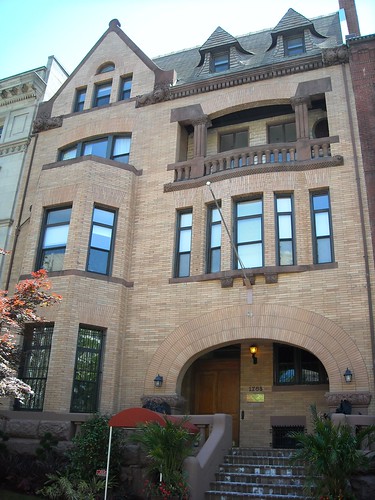
Embassy of Trinidad and Tobago
Trinidad and Tobago is known as the Caribbean country that gave the world calypso, the limbo, Soca, and steel bands. As you might expect then, this country is all about music, dancing, and partying. Trinidad and Tobago consists of two islands joined to form one nation; while part of the Caribbean, it is only eight miles away from South America just off the coast of Venezuela.
The two islands of Trinidad and Tobago are as different and yet complementary as “peanut butter and jelly”. Trinidad is larger, more industrialized, and more multicultural, while Tobago is smaller, quieter, and more oriented to the sea. One of these islands is fabled to be that of Robinson Crusoe’s. Trinidad is less a vacation destination than it is a center of business, except when a festival like Carnival is taking place. Tobago, on the other hand, is more folksy and leisurely, attracting tourists looking for sun, sand, tranquility, and tropical food and drinks. With the two islands linked by air shuttles, it is possible to enjoy the best of both worlds in one trip.
History
At the time Christopher Columbus “discovered” the two islands in 1498, Trinidad and Tobago was home to seven native tribes, including the South American Indians and the Caribs. The Spanish began colonizing the islands in 1530 when they established St. Joseph as a jumping-off point for El Dorado gold-seekers headed for South America. Unfortunately, the Spanish brought with them smallpox, which decimated the native population. In 1595, the colony at St. Joseph was looted and destroyed by the British. The Spanish rebuilt a new town somewhere else along the coast and named it Port of Spain. They set up plantations in the 17th century and imported slaves to work them.
During the colonial period of the 17th and 18th century, Spain, France, Britain, and the Netherlands all fought over the islands. Trinidad was ultimately claimed by the British in 1797 and Tobago was also ceded to them in 1814. The British merged to two islands into one colony. After slavery was abolished in 1834, a labor shortage resulted in immigrants from Europe, United States, the Middle East, Africa, and China being recruited, giving Trinidad and Tobago its colorful mixture of cultures, ethnicities, and creeds.
In 1962, Trinidad and Tobago was granted full independence from the UK. Today, the country is one of the wealthiest in the Caribbean, largely due to its oil and gas reserves and its refineries at Point Fortin and Point-a-Pierre. The country’s economy is also supplemented by the agricultural production of sugar, tobacco, cocoa, and the mining of iron ore, gypsum, pitch asphalt, and coal.
Attractions
Trinidad
Trinidad is an emerald-green island with lush tropical vegetation and tropical forests, among them Mayaro, Cocal, and Valencia. Trinidad also has its fair share of beaches in the north and east coasts including Maracas Bay, Chaguaramas, and Las Cuevas, which all draw waves of scuba divers and swimmers. The north and west coasts of Trinidad also teem with deep-sea fishes – from yellow tuna, to bonito, to Spanish mackerel, to dolphin, to salmon and snapper. Boats can be chartered for those who want to do a little deep-sea fishing. Birdwatching is also popular, especially at Nariva Swamp, Queen’s Park Savannah, Asa Wright Nature Center, the Aripo Savannah, and the Caroni Bird Sanctuary, which features the national bird, the scarlet ibis. The Asa Wright Nature Center, in particular, is home to rare birds like the Guacharo and the oilbird. In addition to birds, the Aripo Savannah also features caves with stalagmites and stalactites that can be explored. Pitch Lake in San Fernando offers an interesting natural phenomenon as an attraction. This 36-acre lake constantly replenishes itself with asphalt.
On the historical and cultural side, you can visit ancient forts like Fort George, which provides spectacular views of Port of Spain and of the Venezuelan mountains. The Amerindian Museum is located in Arima. And the capital, Port of Spain, is home to colonial and Victorian architecture, from medieval castles, to Moorish residences, to gothic cathedrals.
The major attraction of Trinidad is its world-renowned Carnival festival, which starts after Christmas. Calypso tents are set up and performances abound. The festival features steel bands tournaments and parades.
Tobago
The cigar-shaped Tobago is known more for its glittering white beaches and bird sanctuaries. Little Tobago Island is a paradise for birdwatchers. Nature trips and birdwatching tours are available on this islet that is most noted for its various species of hummingbirds. Little Tobago Island can be reached by boat, which regularly operate and leave from Speyside.
Tobago is also full of beautiful beaches. Englishman’s Bay is one of the favorites. It is a hidden beach on the leeward coast of the island, reached only by boat. Swimming and snorkeling is popular in this setting of palm trees, turquoise waters, and white soft sands. It is also a favorite birdwatching spot as well. Other beaches include Man O’War Bay, Bacolet Bays, Store Bay, Turtle Beach, Pirate’s Bay, and Pigeon Point in the northwest. Buccoo Reef is another favorite, noted for its extensive coral reefs and abundant marine life; it is a hot spot for scuba divers. Not to be forgotten is the beach settlement of Speyside, which offers excellent scuba diving and snorkeling.
On the historical and cultural side, Tobago Museum retraces American Indian and colonial history and can be visited in the capital, Scarborough. For a glimpse at a colonial plantation estate, Whim has a large plantation house called Arnos Vale Hotel, which now operates as a hotel. In the fishing town of Plymouth, there are mysterious 18th century inscriptions on a tombstone.


Comments